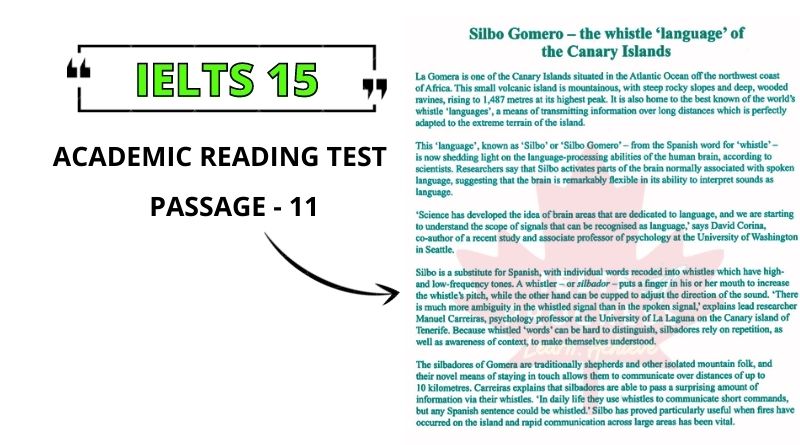IELTS Academic Test – Passage 11: Silbo Gomero – the whistle ‘language’ of the Canary Islands reading with answers explanation, location and pdf. This reading paragraph has been taken from our huge collection of Academic & General Training (GT) Reading practice test PDF’s.

Silbo Gomero – the whistle ‘language’ of the Canary Islands
La Gomera is one of the Canary Islands situated in the Atlantic Ocean off the northwest coast of Africa. This small volcanic island is mountainous, with steep rocky slopes and deep, wooded ravines, rising to 1,487 metres at its highest peak. It is also home to the best known of the world’s whistle ‘languages’, a means of transmitting information over long distances which is perfectly adapted to the extreme terrain of the island.
This ‘language’, known as ‘Silbo’ or ‘Silbo Gomero’ – from the Spanish word for ‘whistle’ – is now shedding light on the language-processing abilities of the human brain, according to scientists. Researchers say that Silbo activates parts of the brain normally associated with spoken language, suggesting that the brain is remarkably flexible in its ability to interpret sounds as language.
‘Science has developed the idea of brain areas that are dedicated to language, and we are starting to understand the scope of signals that can be recognised as language,’ says David Corina, co-author of a recent study and associate professor of psychology at the University of Washington in Seattle.
Silbo is a substitute for Spanish, with individual words recoded into whistles which have high- and low-frequency tones. A whistler – or silbador – puts a finger in his or her mouth to increase the whistle’s pitch, while the other hand can be cupped to adjust the direction of the sound. ‘There is much more ambiguity in the whistled signal than in the spoken signal,’ explains lead researcher Manuel Carreiras, psychology professor at the University of La Laguna on the Canary island of Tenerife. Because whistled ‘words’ can be hard to distinguish, silbadores rely on repetition, as well as awareness of context, to make themselves understood.
The silbadores of Gomera are traditionally shepherds and other isolated mountain folk, and their novel means of staying in touch allows them to communicate over distances of up to 10 kilometres. Carreiras explains that silbadores are able to pass a surprising amount of information via their whistles. ‘In daily life they use whistles to communicate short commands, but any Spanish sentence could be whistled.’ Silbo has proved particularly useful when fires have occurred on the island and rapid communication across large areas has been vital.
The study team used neuroimaging equipment to contrast the brain activity of silbadores while listening to whistled and spoken Spanish. Results showed the left temporal lobe of the brain, which is usually associated with spoken language, was engaged during the processing of Silbo. The researchers found that other key regions in the brain’s frontal lobe also responded to the whistles, including those activated in response to sign language among deaf people. When the experiments were repeated with non-whistlers, however, activation was observed in all areas of the brain.
‘Our results provide more evidence about the flexibility of human capacity for language in a variety of forms,’ Corina says. ‘These data suggest that left-hemisphere language regions are uniquely adapted for communicative purposes, independent of the modality of signal. The non-Silbo speakers were not recognising Silbo as a language. They had nothing to grab onto, so multiple areas of their brains were activated.’
Carreiras says the origins of Silbo Gomero remain obscure, but that indigenous Canary Islanders, who were of North African origin, already had a whistled language when Spain conquered the volcanic islands in the 15th century. Whistled languages survive today in Papua New Guinea, Mexico, Vietnam, Guyana, China, Nepal, Senegal, and a few mountainous pockets in southern Europe. There are thought to be as many as 70 whistled languages still in use, though only 12 have been described and studied scientifically. This form of communication is an adaptation found among cultures where people are often isolated from each other, according to Julien Meyer, a researcher at the Institute of Human Sciences in Lyon, France. ‘They are mostly used in mountains or dense forests,’ he says. ‘Whistled languages are quite clearly defined and represent an original adaptation of the spoken language for the needs of isolated human groups.’
But with modern communication technology now widely available, researchers say whistled languages like Silbo are threatened with extinction. With dwindling numbers of Gomera islanders still fluent in the language, Canaries’ authorities are taking steps to try to ensure its survival. Since 1999, Silbo Gomero has been taught in all of the island’s elementary schools. In addition, locals are seeking assistance from the United Nations Educational, Scientific and Cultural Organization (UNESCO). ‘The local authorities are trying to get an award from the organisation to declare [Silbo Gomero] as something that should be preserved for humanity,’ Carreiras adds.
Questions 14-19
Do the following statements agree with the information given in Reading Passage 2?
In boxes 14-19 on your answer sheet, write
TRUE if the statement agrees with the information
FALSE if the statement contradicts the information
NOT GIVEN if there is no information on this
14. La Gomera is the most mountainous of all the Canary Islands.
15. Silbo is only appropriate for short and simple messages.
16. In the brain-activity study, silbadores and non-whistlers produced different results.
17. The Spanish introduced Silbo to the islands in the 15th century.
18. There is precise data available regarding all of the whistle languages in existence today.
19. The children of Gomera now learn Silbo.
Questions 18-22
Complete the notes below.
Choose ONE WORD ONLY from the passage for each answer.
Write your answers in boxes 20-26 on your answer sheet.
Silbo Gomero
How Silbo is produced
● high- and low-frequency tones represent different sounds in Spanish 20……………
● pitch of whistle is controlled using silbador’s 21……………
● 22………….. is changed with a cupped hand
How Silbo is used
● has long been used by shepherds and people living in secluded locations
● in everyday use for the transmission of brief 23……………
● can relay essential information quickly, e.g. to inform people about 24……………
The future of Silbo
● future under threat because of new 25……………
● Canaries’ authorities hoping to receive a UNESCO 26……………. to help preserve it
________________
ALSO TRY:
1) IELTS 15 READING PASSAGE – THE DESOLENATOR: PRODUCING CLEAN WATER ↗
2) IELTS 15 READING PASSAGE – WHY FAIRY TALES ARE REALLY SCARY TALES ↗
3) IELTS 15 READING PASSAGE – THE RETURN OF THE HUARANGO ↗
4) IELTS 15 READING PASSAGE – HENRY MOORE (1898-1986) ↗
5) IELTS 15 READING PASSAGE – ENVIRONMENTAL PRACTICES OF BUSINESSES ↗
________________
Answers with Explanation
Check out Silbo Gomero – the whistle ‘language’ of the Canary Islands reading answers below with explanations and locations given in the text.
14. NOT GIVEN
15. FALSE
16. TRUE
17. FALSE
18. FALSE
19. TRUE
20. words
21. finger
22. direction
23. commands
24. fires
25. technology
26. award
Have any doubts??? Discuss in the comments ...
If you want the pdf summary of Silbo Gomero – the whistle ‘language’ of the Canary Islands reading passage and answers, please write your email in the comment section below. We’ll send it across at the speed of light.

ALL THE BEST !
Hello Kindly Send Me PDF Of Information About Silbo Gomero – the whistle ‘language’ of the Canary Islands